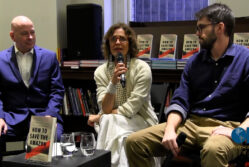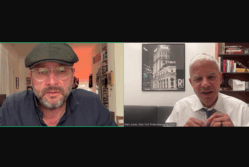Event Coverage Highlight

OPC Photography Award Winners Discuss Challenges
by Chad Bouchard
Winners of the OPC’s three photography award categories shared behind-the-scenes insights of their work, discussing the challenges of operating in conflict areas as well as the often thorny ethics of telling stories while maintaining respect for sensitivity, privacy and the safety of sources as well as themselves.
On June 10, 2020, the OPC hosted an online discussion via Zoom with this year’s photography award winners, including Dieu Nalio Chery of The Associated Press, winner of the Robert Capa Gold Medal Award for best photographic reporting from abroad requiring exceptional courage and enterprise; Moises Saman of National Geographic, winner of the Olivier Rebbot Award for best photographic news reporting from abroad in any medium; and Rena Effendi of The Wall Street Journal, winner of the Best Feature Photography award for best feature photography on an international theme published in any medium.
Freelance photographer Daniella Zalcman, who served as head judge for the OPC’s photography awards jury, moderated the panel. In introducing Chery and the Capa Award, she highlighted the importance of the word “courage” that sets the award apart from the other photo categories.
“Courage in the context of photojournalism can mean a lot of different things. But especially this month, especially these past few weeks, as we think about the police violence and the brutality that we’ve been witnessing in the United States, and we think about the ways in which our colleagues are being harassed and assaulted simply for trying to their jobs, to tell stories, it feels like a very relevant moment to hear about Dieu Nalio’s work.”
Chery’s series covered clashes between police and anti-government demonstrators in Haiti. He was shot and wounded while covering a protest in September after a Haitian senator fired a pistol during a confrontation with protesters just outside the country’s parliament in Port-au-Prince.
Chery said protests in 2019 erupted over suspected corruption in an oil deal between Haiti’s government and Venezuela, at the same time the country was seeing gas shortages. When President Jovenel Moïse tried to install a new Prime Minister in September, opposition members clashed with the ruling party inside Parliament, and violence spilled onto the street.
“At that time, I got shot in my chin,” Chery said. A three-month lockdown followed while he recovered from the shooting injury. “Children couldn’t go to school, no businesses, no banks, nothing was open. So the country was completely down, and people who were poor got more poor.”
Two Haitian journalists were killed last year, Chery said. He added that it is very difficult to operate as a photojournalist in the country right now, because gangs have control over the streets,
Zalcman said the photography jury this year grappled with the role of images in media saturated with depictions of violence.
“We are constantly torn between understanding that we need to see the worst of humanity, we need to see atrocities that are being committed and also what happens when we only consume those images, when we place those image at the forefront of our consciousness.”
In introducing Saman’s winning work, which judges called “wholistic documentation” of the migrant crisis in El Salvador, she said Saman’s images “reflect the complexity of the situation that is too often only documented through scenes of gore.”
Saman pointed out that the award’s namesake, French photographer Olivier Rebbot, was shot by a sniper while covering the civil war in El Salvador for Newsweek magazine in February 1981.
“The challenge with this story was to get a little bit beyond the stereotypical images of violence, to provide a more layered version of events” that would delve into the origins of the current turmoil.
He said the story started as an immigration story in the aftermath of President Trump removing temporary protection status for 200,000 Salvadorans living in the U.S.
“We wanted to understand the dynamics and the drivers of a second cycle of people wanting to reach the United States,” Saman said. Violence is a big factor, he added, “but so is poverty, and so is the legacy of the civil war” in the early 1980s.
Saman went to El Salvador twice for the assignment with a writer. Amid gang wars and violence, they traveled to less-covered rural areas and reported on religious life of people trying to cope, including Morazán, which had been a hotbed of conflict in the civil war 4 decades ago.
An attendee asked the panelists about the ethical challenges connected to their work. Effendi, whose subjects for the story included children who could be stigmatized for their parents’ roles in ISIS, said she treaded a fine line between the need to keep the children’s identities private, and making sure they would not be dehumanized by having their faces blurred or blacked out.
“I wanted to show their faces because they’re children. We need to fight this kind of branding and mentality. They’re innocent and it wasn’t their choice,” she said.
“I showed the faces but not too directly. The most direct photograph is that of a baby, but now he’s unrecognizable” as the same person in the photograph, because several months have gone by since they arrived in Sweden. She used shadows and off-center angles to obscure their identities without stripping their identities.
Other judges on the photography jury this year were Noelle Flores Theard of the Magnum Foundation, Natalia Jimenez of the Washington Post, freelancer Cinthya Santos Briones, and Mikhael Simmonds of the Solutions Journalism Network.



